What to Use Instead of Psyllium Husk Powder in Baking: 11 Best Alternatives for Perfect Results
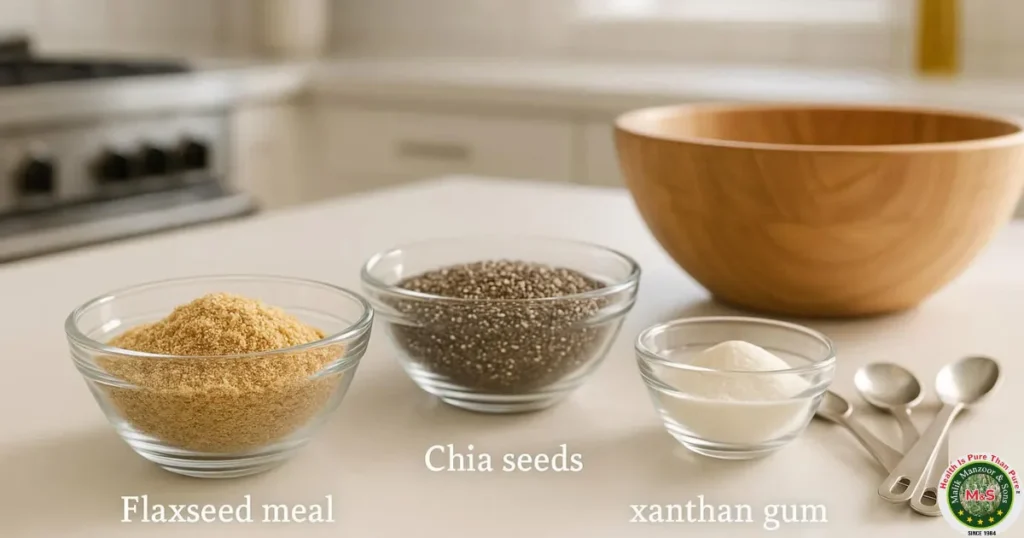
Psyllium husk powder has become a staple in gluten-free and low-carb baking, prized for its binding properties and fiber content. But what happens when you’re halfway through a recipe and realize you’re out? Whether you’re dealing with allergies, availability issues, or want to experiment with different ingredients, finding the right substitute can make or break your baking project.
Understanding what to use instead of psyllium husk powder in baking is essential for anyone following specialized diets or exploring alternative baking methods. The good news is that several effective substitutes can deliver similar texture, structure, and moisture retention without compromising your final product. This comprehensive guide explores proven alternatives that work in various baking applications, from bread and muffins to cookies and pastries.
What Makes Psyllium Husk Powder Special in Baking
Before diving into substitutes, it’s important to understand why psyllium husk powder works so well in baking. This soluble fiber from the Plantago ovata plant absorbs liquid up to ten times its weight, creating a gel-like consistency that mimics the elasticity of gluten. This property makes it invaluable in gluten-free recipes where traditional wheat flour isn’t an option.
Psyllium husk powder provides structural integrity, helps dough hold together, improves texture, and extends shelf life by retaining moisture. It also adds negligible flavor, allowing other ingredients to shine. When searching for what to use instead of psyllium husk powder in baking, you’ll want alternatives that replicate at least some of these characteristics.
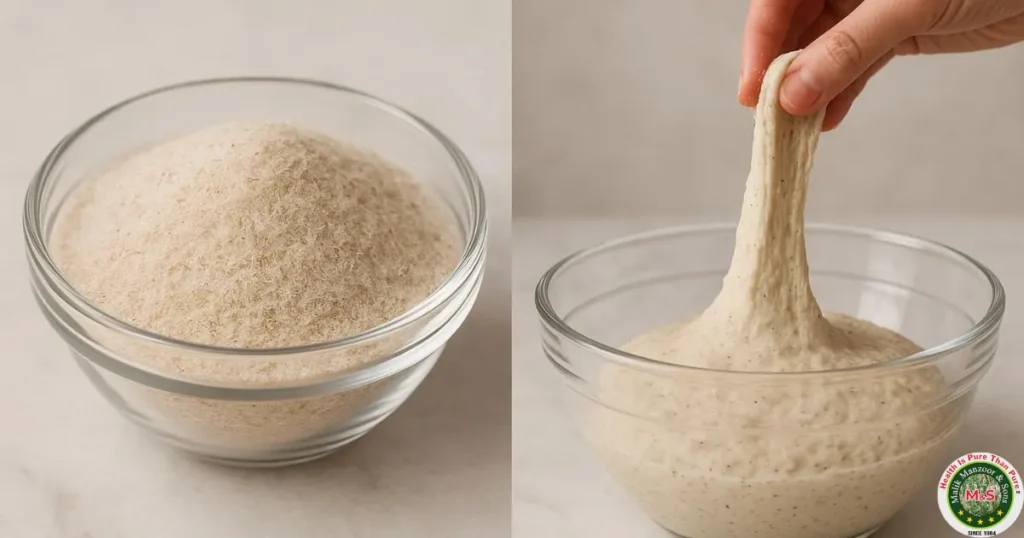
Top 11 Psyllium Husk Powder Substitutes for Baking
Flaxseed Meal
Ground flaxseeds, or flaxseed meal, stand as one of the most popular alternatives. When mixed with water, flaxseeds create a gel similar to psyllium, making them excellent for binding. Use three tablespoons of flaxseed meal mixed with one tablespoon of water to replace one tablespoon of psyllium husk powder.
Flaxseed meal works particularly well in muffins, pancakes, and quick breads. The slightly nutty flavor complements whole grain and hearty recipes. Keep in mind that flaxseeds add a light brown color and subtle taste, which may affect delicate recipes. They also provide omega-3 fatty acids and additional fiber, making them nutritionally comparable to psyllium.
Chia Seeds
Chia seeds function similarly to flaxseeds, forming a gel when combined with liquid. Use the same ratio as flaxseed meal, mixing three tablespoons of ground chia seeds with one tablespoon of water per tablespoon of psyllium husk powder needed.
These tiny seeds work exceptionally well in cookies, energy bars, and breakfast baked goods. Whole chia seeds add a pleasant crunch, while ground chia provides smoother binding. The neutral taste makes chia more versatile than flaxseed in recipes where you don’t want additional flavor. Chia seeds also offer complete protein and antioxidants alongside their binding properties, which makes them a top choice when figuring out what to use instead of psyllium husk powder in baking.
Xanthan Gum
This commercial food additive serves as a powerful binding agent in gluten-free baking. Because xanthan gum is significantly more potent than psyllium husk powder, you’ll need much less. Use approximately half a teaspoon of xanthan gum to replace one tablespoon of psyllium husk powder.
Xanthan gum excels in bread, pizza dough, and cake recipes where structure is crucial. It creates elasticity without adding bulk or altering flavor. However, using too much can result in a gummy texture, so measure carefully. Some people experience digestive sensitivity to xanthan gum, making it less suitable for everyone compared to natural fiber sources.
Guar Gum
Similar to xanthan gum but derived from guar beans, guar gum provides excellent binding and thickening properties. Use the same substitution ratio as xanthan gum, about half a teaspoon per tablespoon of psyllium husk powder.
Guar gum works well in cold applications and baked goods requiring a soft, tender crumb, like cakes and muffins. It’s generally more affordable than xanthan gum and may be better tolerated by those with corn sensitivities. The binding power rivals xanthan gum, making it another concentrated alternative when figuring out what to use instead of psyllium husk powder in baking.
Ground Chia and Flax Blend
Combining ground chia seeds and flaxseed meal creates a balanced substitute that leverages the strengths of both ingredients. Mix equal parts of each and use three tablespoons of the blend with one tablespoon of water to replace one tablespoon of psyllium husk powder.
This combination works beautifully in most baking applications, from bread to brownies. The blend provides robust binding, moisture retention, and nutritional benefits without overwhelming flavor. This option gives you flexibility and typically produces consistent results across various recipes.
Egg Whites
For those not following a vegan diet, egg whites offer excellent binding and structure. One egg white can replace approximately one tablespoon of psyllium husk powder in most recipes.
Egg whites work particularly well in cookies, meringues, and light cakes where you want lift and structure. They add protein without fat and create tender, cohesive results. However, they obviously change the nutritional profile and aren’t suitable for vegan baking. They also add more liquid to recipes, which may require slight adjustments to other wet ingredients.
Gelatin
Unflavored gelatin provides binding properties similar to psyllium when bloomed in water. Use one teaspoon of gelatin bloomed in three tablespoons of water to replace one tablespoon of psyllium husk powder.
Gelatin works best in recipes requiring firm structure, like protein bars, certain breads, and denser baked goods. It’s not suitable for vegetarians or vegans, and it requires proper blooming before incorporation. Gelatin can also affect texture if used incorrectly, so follow instructions carefully when considering what to use instead of psyllium husk powder in baking.
Arrowroot Powder
Arrowroot powder functions primarily as a thickener but can provide some binding in baking. Use two tablespoons of arrowroot powder to replace one tablespoon of psyllium husk powder.
This substitute works well in cookies, crackers, and lighter baked goods. Arrowroot creates a crispy texture rather than the chewy quality psyllium provides, making it ideal for specific applications. It’s flavorless, easily digestible, and hypoallergenic, making it suitable for sensitive individuals. However, it doesn’t absorb as much moisture as psyllium, so that recipes may need adjustments.
Oat Fiber
Finely ground oat fiber can mimic some of psyllium’s bulk and absorbency. Use two to three tablespoons of oat fiber to replace one tablespoon of psyllium husk powder.
Oat fiber works well in bread, muffins, and high-fiber baked goods. It adds significant fiber content without many calories, making it popular in low-carb baking. The mild oat flavor complements most recipes, though it’s more noticeable than psyllium’s neutral taste. Ensure you’re using oat fiber, not oat flour, as they have different properties. It can be the least option when figuring out what to use instead of psyllium husk powder in baking.
Coconut Flour
While coconut flour doesn’t bind exactly like psyllium, it absorbs tremendous amounts of liquid, making it useful in certain applications. Use two tablespoons of coconut flour plus an extra egg or equivalent to replace one tablespoon of psyllium husk powder.
Coconut flour works best in pancakes, muffins, and cakes, where its subtle sweetness enhances the recipe. It adds protein and fiber while remaining grain-free. The coconut flavor may not suit all recipes, and coconut flour significantly changes texture, creating denser, more cake-like results. Additional liquid is usually necessary when substituting coconut flour.
Commercial Egg Replacers
Several commercial egg replacer products can substitute for psyllium husk powder in baking. Follow package directions, typically using the equivalent of one egg to replace one tablespoon of psyllium husk powder.
These products work across various recipes, from cookies to cakes, and are formulated specifically for binding. Brands often use combinations of starches, leavening agents, and gums to achieve reliable results. They’re convenient and consistent but may contain additives or allergens, so check ingredients carefully.
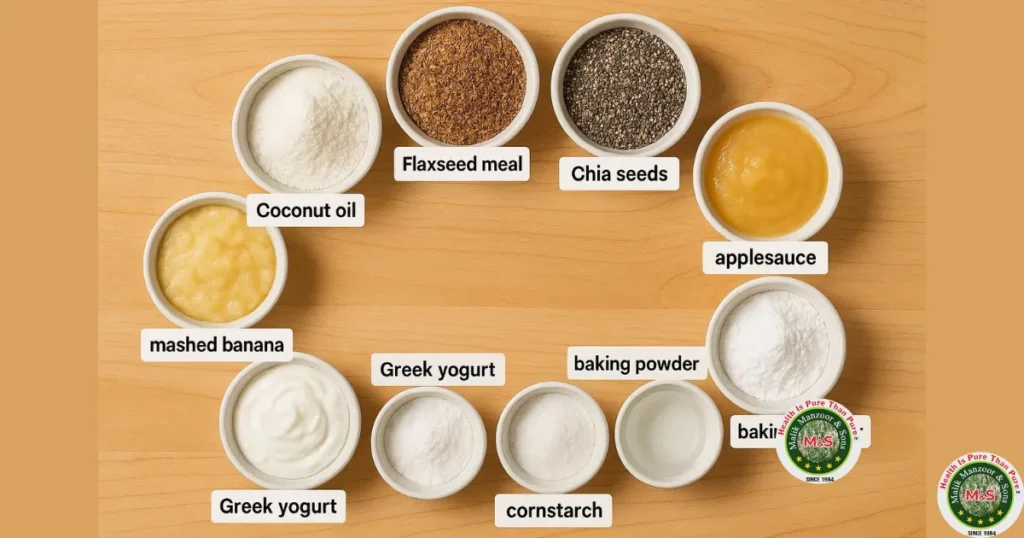
How to Choose the Right Substitute for Your Recipe
Selecting what to use instead of psyllium husk powder in baking depends on several factors. Consider the recipe type first. Bread and pizza dough require strong binding, making xanthan gum or guar gum ideal. Cookies and muffins work well with flaxseed meal or chia seeds. Cakes benefit from egg whites or commercial egg replacers.
Dietary restrictions play a crucial role. Vegan bakers should stick with plant-based options like flaxseed, chia, or commercial vegan egg replacers. Those with nut allergies should avoid certain commercial products. Low-carb dieters might prefer oat fiber or coconut flour, while those seeking maximum fiber should consider flaxseed or chia seeds.
Flavor considerations matter too. Flaxseed adds nutty notes, coconut flour brings subtle sweetness, and most gums remain flavorless. Match the substitute’s flavor profile to your recipe. Texture goals also influence your choice. If you want a chewy texture, try flaxseed or chia. For crispy results, consider arrowroot powder. For light and airy, egg whites work beautifully.
Conversion Chart for Easy Reference
Understanding proper ratios ensures success when substituting what to use instead of psyllium husk powder in baking. For one tablespoon of psyllium husk powder, use three tablespoons flaxseed meal plus one tablespoon water, three tablespoons ground chia seeds plus one tablespoon water, half teaspoon xanthan gum, half teaspoon guar gum, one egg white, one teaspoon gelatin bloomed in three tablespoons water, two tablespoons arrowroot powder, two to three tablespoons oat fiber, two tablespoons coconut flour plus extra liquid, or follow commercial egg replacer package directions.
Remember, these are starting points. Recipe adjustments may be necessary based on other ingredients and desired outcomes.
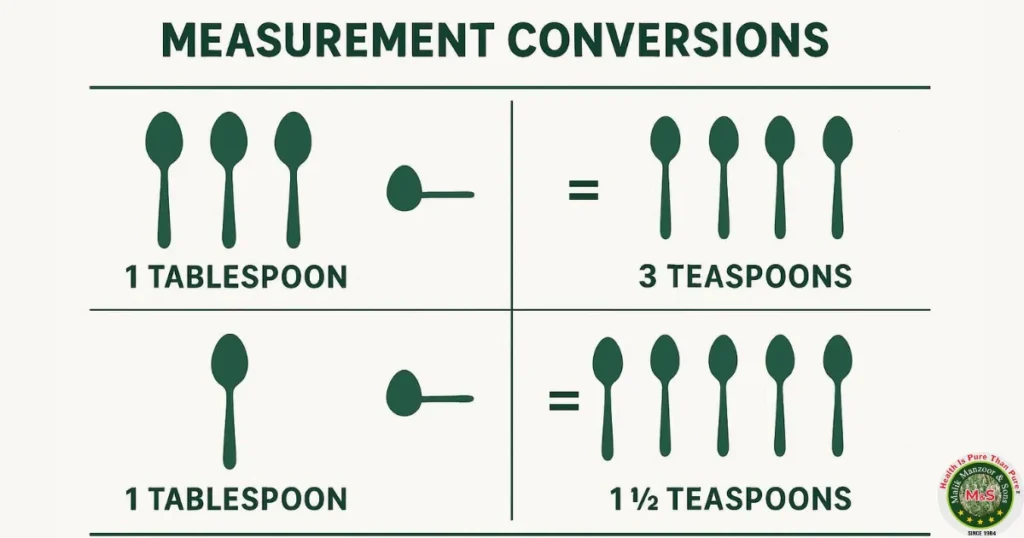
Common Baking Challenges and Solutions
When figuring out what to use instead of psyllium husk powder in baking, you might encounter challenges. If dough seems too wet, add more flour gradually, one tablespoon at a time. If the dough is too dry and crumbly, add liquid incrementally, starting with one teaspoon.
Baked goods falling apart indicate insufficient binding. Try increasing your substitute amount by 25 percent or adding an extra egg or egg white. Dense, heavy texture suggests too much binding agent. Reduce the substitute amount or increase the leavening agents slightly.
A gummy or slimy texture typically results from too much xanthan or guar gum. Cut the amount in half next time. Off-flavors occur when substitutes like flaxseed or coconut flour overwhelm delicate recipes. Consider neutral options like xanthan gum or egg whites for subtle-flavored baked goods.
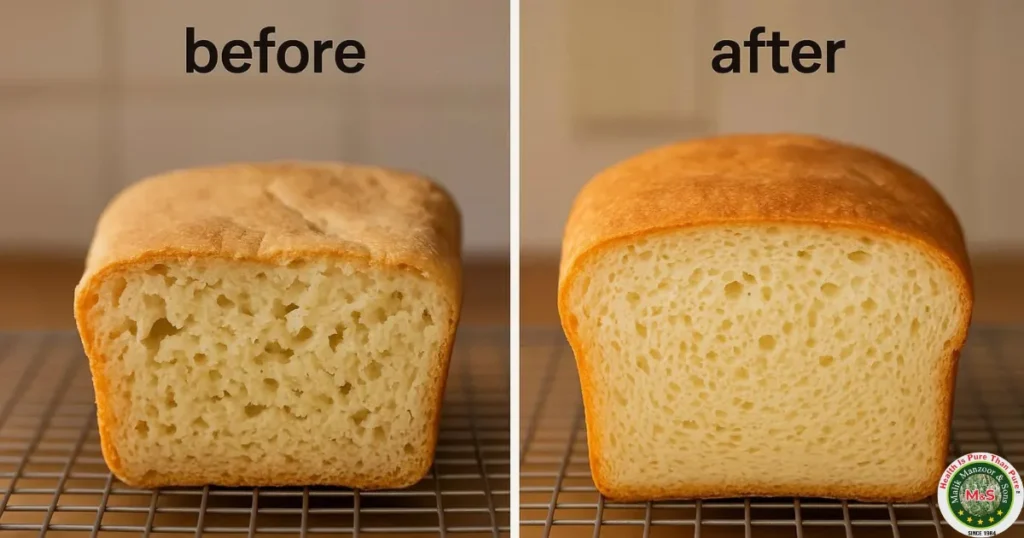
Expert Tips for Successful Substitution of what to use instead of psyllium husk powder in baking
Always let mixed substitutes rest. When using flaxseed or chia, allow the mixture to sit for five to ten minutes before adding to your recipe. This activates the gel-like properties essential for binding. Add substitutes gradually. Start with the recommended amount, then adjust as needed based on dough consistency.
Consider combining substitutes for better results. A blend of flaxseed and xanthan gum often outperforms either alone. Don’t overmix your batter. Overworking dough with substitutes can lead to tough, dense results. Mix just until combined for optimal texture.
Adjust baking times as needed. Substitutes may alter how quickly baked goods cook. Check for doneness a few minutes earlier than usual. Keep detailed notes about what works. Baking is as much science as art, and tracking successful substitutions helps you refine your technique.
Nutritional Comparison of Substitutes
Understanding the nutritional profiles helps you choose substitutes aligned with your health goals. Flaxseed meal provides omega-3 fatty acids, lignans, and approximately 37 calories per tablespoon. Chia seeds offer complete protein, omega-3s, and about 60 calories per tablespoon. Xanthan and guar gum contain negligible calories and primarily add soluble fiber.
Egg whites deliver pure protein with roughly 17 calories and no fat or carbs per large egg white. Coconut flour is rich in fiber and healthy fats with around 120 calories per quarter cup. Arrowroot powder consists mainly of starch with approximately 65 calories per quarter cup and minimal fiber. Oat fiber provides substantial insoluble fiber with very few digestible carbs and calories.
When health is a priority, natural options like those offered by trusted brands like Malik Psyllium maintain purity without unnecessary processing. Whether choosing psyllium or alternatives, quality matters for both baking performance and nutritional value.
Recipe Adjustment Guidelines
Successfully implementing what to use instead of psyllium husk powder in baking requires understanding recipe adjustments. Start by replacing psyllium one-to-one with your chosen substitute using conversion ratios. Test a small batch first before committing to large quantities.
Monitor moisture levels closely. Add flour if the batter seems too thin, or liquid if too thick. Make small adjustments rather than large changes. Allow extra resting time for dough or batter. Substitutes may need additional time to fully hydrate and bind.
Be prepared to adjust baking temperature or time slightly. Some substitutes brown faster or slower than psyllium. Watch your baked goods closely, especially the first time using a new substitute. Don’t be discouraged by initial failures. Finding the perfect substitute for your favorite recipe takes experimentation and patience.
Pros and Cons of Popular Substitutes
The following are the options for what to use instead of psyllium husk powder in baking:
Flaxseed Meal
Pros: Nutritionally dense, widely available, affordable, provides omega-3s.
Cons: Adds nutty flavor, changes color, requires grinding, shorter shelf life
Chia Seeds
Pros: Neutral flavor, complete protein, shelf-stable, versatile
Cons: More expensive, visible seeds unless ground, gel texture varies
Xanthan Gum
Pros: Powerful binding, flavorless, long shelf life, small quantity needed
Cons: Highly processed, potential digestive issues, expensive per use, easy to overuse
Egg Whites
Pros: Excellent binding, adds protein, readily available, familiar ingredient
Cons: Not vegan, potential allergen, adds moisture, changes nutritional profile
Coconut Flour
Pros: Grain-free, high fiber, subtle sweetness, nutrient-dense
Cons: Strong flavor, very absorbent, requires recipe modification, expensive
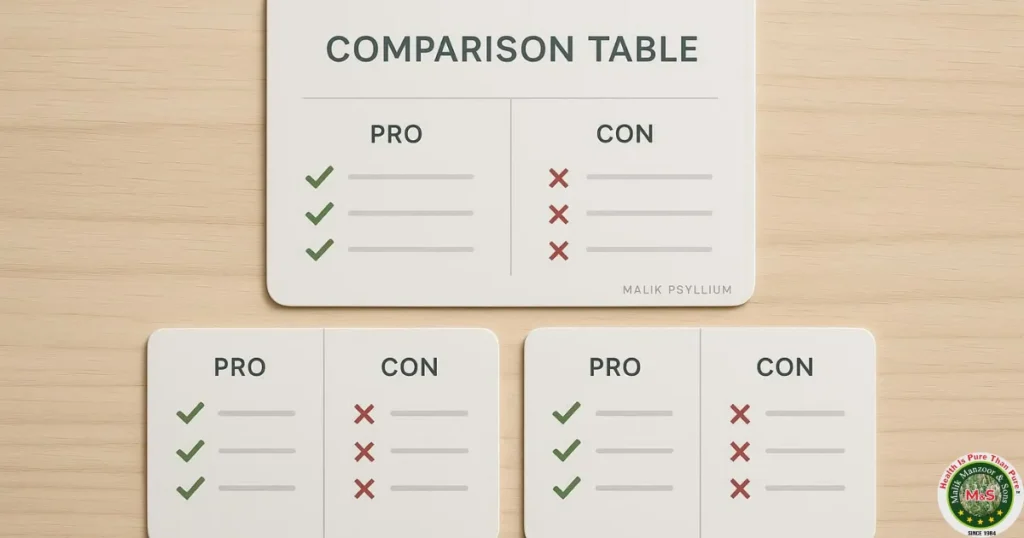
Building Confidence with Substitutions
Mastering what to use instead of psyllium husk powder in baking empowers you to handle any kitchen situation. Start with recipes specifically designed for your chosen substitute. Many cookbooks and websites feature recipes optimized for flaxseed, chia, or other alternatives.
Join online baking communities where members share experiences with substitutions. Learning from others’ successes and mistakes accelerates your progress. Keep a well-stocked pantry with multiple baking substitute options. Having flaxseed, chia, xanthan gum, and other alternatives on hand provides flexibility.
Practice with forgiving recipes first. Muffins, cookies, and quick breads tolerate substitution better than delicate pastries or bread. Build your skills gradually before tackling complex projects. Document your experiments thoroughly. Note what worked, what didn’t, and why. This personal reference guide becomes invaluable over time.
Can I use ground psyllium husk instead of powder in baking?
Yes, ground psyllium husk works similarly to powder but may have a slightly coarser texture. Use the same measurements, though you might need to increase the liquid slightly since ground husk absorbs less than finely powdered versions.
What is the best substitute for psyllium husk powder in keto bread?
Xanthan gum or a combination of flaxseed meal and oat fiber works excellently in keto bread recipes. These maintain low carb counts while providing necessary binding and structure for successful bread texture.
Can I skip psyllium husk powder entirely without replacing it?
In some recipes, particularly those with eggs and sufficient structure from other ingredients, you might omit psyllium without replacement. However, most gluten-free recipes will suffer in texture and binding without a suitable substitute.
Does flaxseed work as well as psyllium husk powder for binding?
Flaxseed provides good binding but functions differently from psyllium. It works best when ground and mixed with water to form a gel. While effective in many recipes, it adds flavor and color that psyllium doesn’t.
What happens if I use too much xanthan gum instead of psyllium?
Excessive xanthan gum creates a gummy, slimy texture and can make baked goods heavy. Since xanthan gum is much more concentrated than psyllium, use only about half a teaspoon per tablespoon of psyllium called for in recipes.
Are chia seeds better than flaxseeds for replacing psyllium in baking?
Neither is objectively better; both work effectively but differently. Chia seeds have a more neutral flavor, making them suitable for delicate recipes. Flaxseeds offer more omega-3s and work well in hearty baked goods where nutty flavor complements other ingredients.
Final Thoughts
Finding what to use instead of psyllium husk powder in baking opens new possibilities for your culinary adventures. Whether you choose flaxseed meal, chia seeds, xanthan gum, or any other alternative, success comes from understanding how each substitute functions and adjusting recipes accordingly. Each option brings unique properties, flavors, and nutritional benefits to your baked goods.
The key lies in experimentation, patience, and attention to detail. Start with recommended ratios, make small adjustments, and don’t fear failure. Every baker experiences setbacks when trying new techniques. With practice, you’ll develop intuition about which substitute works best for different applications and personal preferences
Malik Shabbir
Featured Blogs
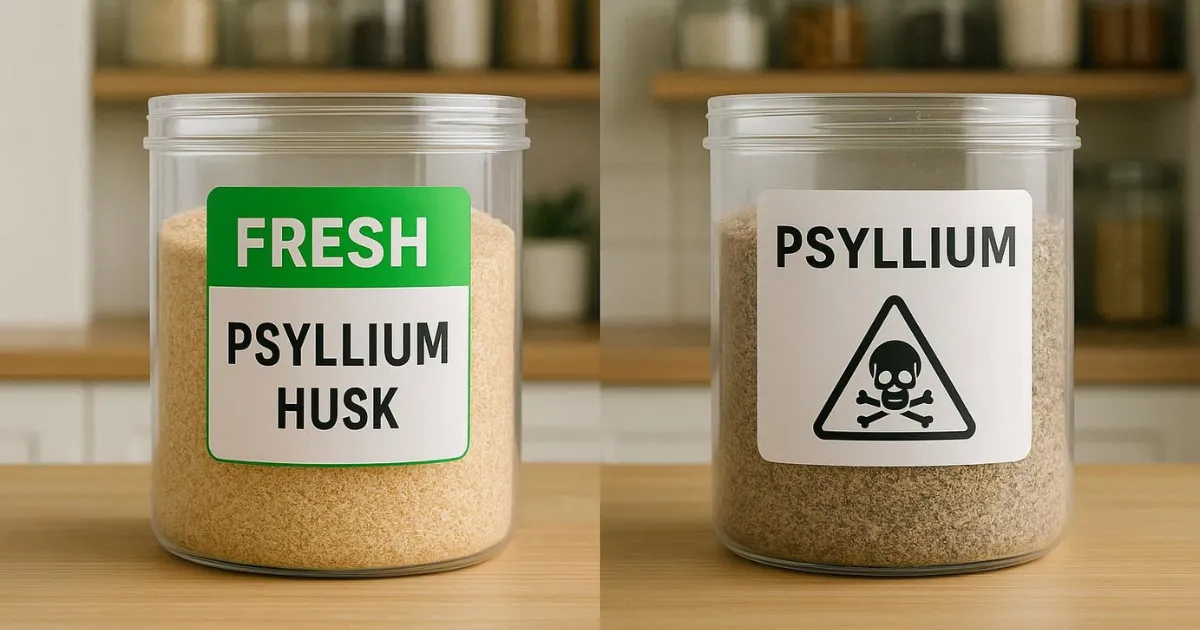
Expired Psyllium Husk Powder: Safety, Shelf Life & When to Discard It
You’re cleaning out your pantry and discover a container of
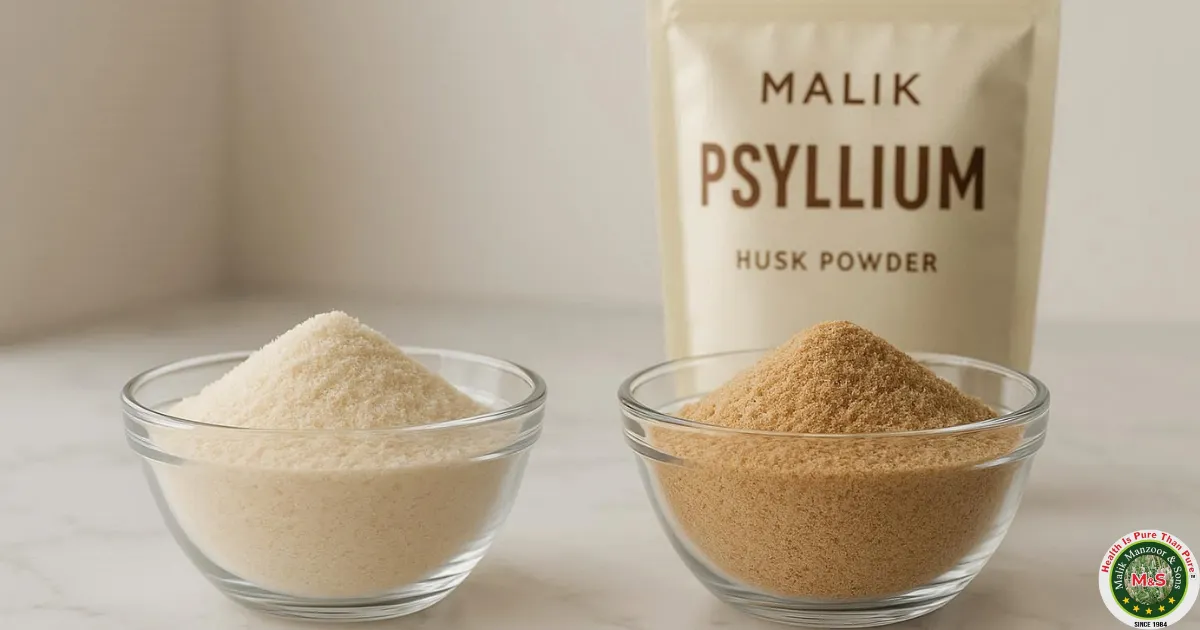
Blond Psyllium Husk Powder vs Ground Psyllium Husk Powder: Complete Guide to Types, Benefits & Uses
When browsing fiber supplements or gluten-free baking ingredients, you’ve likely
